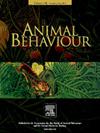Visual learning, route formation and the choreography of looking back in desert ants, Melophorus bagoti
IF 2.3
2区 生物学
Q2 BEHAVIORAL SCIENCES
引用次数: 0
Abstract
How ants, wasps and bees rapidly form visual routes represents an enduring mystery as well as a powerful example of the abilities of small brains. Here, we detailed a previously uncharacterized behaviour, ‘lookbacks’, which is theorized to underly rapid bidirectional route learning in desert ants. During these lookbacks, foragers stop forward movement to their goal location, turn and fixate their gaze on their origin, often for only 150–200 ms. This turn appears to be a period for learning the inbound route. Route formation relies on acquiring visual cues and comparing panoramic view memories with the current view. Although the nest panorama is learned during preforaging learning walks, during which naïve ants often fixate their gaze towards the nest, route following requires separate behaviours to learn route-based views. We untangle how route formation occurs in naïve desert ant, Melophorus bagoti, foragers during the first foraging trips by focusing on these lookback behaviours and their potential function in facilitating visual learning. Lookbacks were highly associated with the first few foraging trips and were concentrated in areas where the visual scene changed rapidly, resulting in increased unfamiliarity among naïve foragers. Analysis of gaze directions during lookbacks shows foragers pause intermittently, fixating their gaze in multiple directions during the turn with the longest of these being back at their origin, likely learning these views during their first foraging trips. We discussed the structure of lookbacks and how they may prime visual learning in ants and other insects.
求助全文
约1分钟内获得全文
求助全文
来源期刊

Animal Behaviour
生物-动物学
CiteScore
4.60
自引率
8.00%
发文量
236
审稿时长
10.2 weeks
期刊介绍:
Growing interest in behavioural biology and the international reputation of Animal Behaviour prompted an expansion to monthly publication in 1989. Animal Behaviour continues to be the journal of choice for biologists, ethologists, psychologists, physiologists, and veterinarians with an interest in the subject.
 求助内容:
求助内容: 应助结果提醒方式:
应助结果提醒方式:


